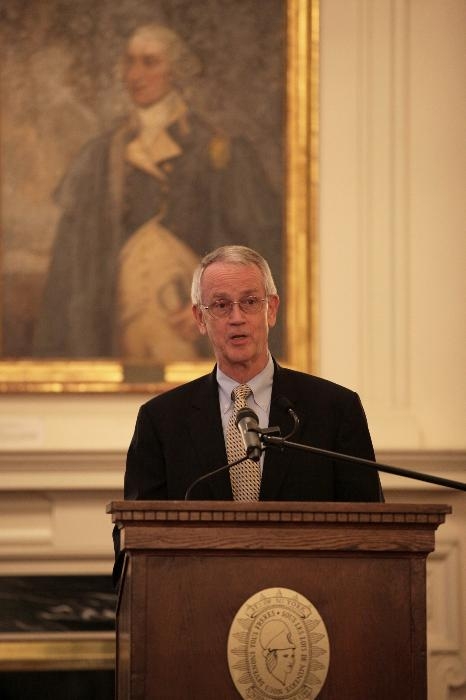The integration of engineering and the liberal arts is essential to compete in a highly competitive and technology-based global economy, one of the nation’s top engineers told a group of educators this weekend.
Charles M. Vest, president of the National Academy of Engineering and president emeritus of the Massachusetts Institute of Technology, also said the liberal arts must take charge of the online learning revolution sweeping across campuses today.
“As populations grow, migrate, and urbanize, and as challenges of climate change and human and natural threats to society increase, we will need to achieve security and resilience through the engineering of very large systems,” said Vest. He was the keynote speaker Friday for Union’s fifth annual symposium on integrating liberal arts with engineering.
“Such systems cannot be wisely envisioned, designed or deployed without an understanding of society, culture, politics, economics and communications - in other words, the very stuff of the liberal arts and also of the social sciences.”
Leaders from a number of schools, including Swarthmore, Trinity, Oklahoma State, California Polytechnic University and Rensselaer Polytechnic Institute, gathered in six sessions to share different models for bringing together engineering, technology and the traditional liberal arts.
Citing intensely popular online courses at such places as Stanford and MIT that have enrolled more than 100,000 students, Vest said a fundamental transformation will soon shake higher education. Much like the past 40 years, when the best use of information technology on campuses originated in the humanities and the arts, the opportunity is again there, he said.
“The liberal arts should surge ahead and lead this revolution,” Vest said. “Indeed, new entities like Coursera, a collaboration among Stanford, Michigan, Princeton and Penn, will add this dimension to on-line offerings. And MIT and Harvard have joined forces to form EDx.
“If you do so, at minimum, it will be a collaboration between humanists and others who will create content with engineers who will enable it. But better still would be collaborations in all dimensions to make sure that the coming educational tsunami serves vital human purposes and enables us to work together to meet the grand challenges of our time.”
The three-day symposium kicked off with dinner and opening remarks by President Stephen C. Ainlay, who helped launch the symposium series in 2008.
Vest was introduced by John E. Kelly III ’76, senior vice president and director of research at IBM.
In 1845, Union became the first liberal arts college to offer engineering. Calling Union a leader in promoting the integration of the two disciplines, Vest cited a number of challenges that engineers face in the 21st century, from providing access to clean water to advancing healthcare informatics. None can be solved by technology and engineering alone, he warned.
“We need writers and artists who keep in our minds the necessity to bequeath a clean, healthy and naturally beautiful environment to our children and grandchildren,” he said. “We need to understand different cultures if we are to enable positive change through introduction of technologies on a global scale.”
Vest touched on the genius of Charles Proteus Steinmetz (1865-1923), who taught electrical engineering and applied physics at Union and was chief consulting engineer for the General Electric Company. He also mentioned the recent best-selling biography of Apple co-founder Steve Jobs by Walter Issacson. The book traces the impact of a calligraphy course Jobs took at Reed College on his ideas of design and user interfaces, and shares his interest in Zen Buddhism and his love of Bach and Dylan.
“Is there a simple formula that says if engineering students take a few liberal arts courses they will become creative and innovative? Of course not,” Vest said. “But as the Jobs story among many others shows, different ways of thinking, analyzing, and knowing can combine with the purely technical to work wonders.”
A number of Union faculty presented at the symposium, which was chaired by Andrew Rapoff, director of engineering and associate professor of mechanical engineering. Other committee members included Brad Bruno (Mechanical Engineering), Helen Hanson (Electrical Engineering) Hans-Friedrich Mueller (Classics), Mark Walker (History) and Lilian Wu of IBM’s Global University Programs.
The opening session featured Timothy J. Kriewall of the Kern Entrepreneurship Education Network (KEEN), who discussed “A Whole New Engineering Model,” and the need for students to have a strong liberal arts influence to thrive in a technology-driven society.
Union is among 20 schools who have received support from KEEN to develop more entrepreneurial-minded students by updating current curriculum, hosting best practices workshops by KEEN for faculty and creating a speaker series.
This year’s symposium was funded in part by the David Falk ’39 and Elynor Rudnick-Falk Endowed Fund and the Laurence W. Levine ’52 and Barry Traub ’53 Endowed Lecture Fund. Previous supporters have included the William and Flora Hewlett Foundation, and the Andrew W. Mellon Foundation.
